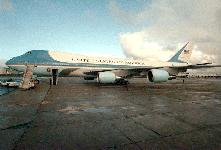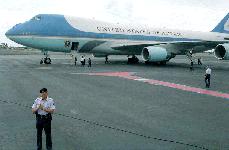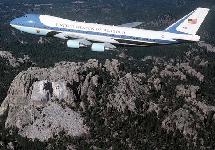FAS |
Military |
DOD 101 |
Systems |
Aircraft ||||
Index |
Search |
Join FAS



VC-25A - Air Force One
The mission of the VC-25A aircraft -- Air Force One -- is to provide air transport for the president of the United States. The presidential air transport fleet consists of two specially configured Boeing 747-200B's -- tail numbers 28000 and 29000 -- with the Air Force designation VC-25A. When the president is aboard either aircraft, or any Air Force aircraft, the radio call sign is "Air Force One."Principal differences between the VC-25A and the standard Boeing 747, other than the number of passengers carried, are the electronic and communications equipment aboard Air Force One, its interior configuration and furnishings, self-contained baggage loader, front and aft air-stairs, and the capability for inflight refueling.
Accommodations for the president include an executive suite consisting of a stateroom (with dressing room, lavatory and shower) and the president's office. A conference/dining room is also available for the president, his family and staff. Other separate accommodations are provided for guests, senior staff, Secret Service and security personnel, and the news media. Two galleys provide up to 100 meals at one sitting. Six passenger lavatories, including disabled access facilities, are provided as well as a rest area and mini-galley for the aircrew. The VC-25A also has a compartment outfitted with medical equipment and supplies for minor medical emergencies.
These aircraft are flown by the presidential aircrew, maintained by the Presidential Maintenance Branch, and are assigned to Air Mobility Command's 89th Airlift Wing, Andrews Air Force Base, Md.
The first VC-25A -- tail number 28000 -- flew as "Air Force One" on Sept. 6, 1990, when it transported President George Bush to Kansas, Florida and back to Washington, D.C. A second VC-25A, tail number 29000 transported President Bill Clinton and former Presidents Carter and Bush to Israel for the funeral of Prime Minister Yitzhak Rabin. The VC-25A will usher presidential travel into the 21st century, upholding the proud tradition and distinction of being known as "Air Force One."
VC-25 aircraft are extensively modified B-747-200s with the basic airframe technology of the 1960s. The aircraft incorporates state-of-the-art avionics and communications equipment with Stage III compliant engines. Boeing is currently delivering B-747s throughout the world, so the logistics support base appears secure for the foreseeable future. With the continuing march of technology and the prestige attached to the U.S. Presidential airlift fleet, Air Force plans recommend a system review date of 2010. At this point, the aircraft will have been in service 20 years, and commercial operators will have retired their B-747-200s counterparts from front-line service.
Specifications | |
| Primary Function | Presidential air transport |
| Contractor | Boeing Airplane Co. |
| Power Plant | Four General Electric CF6-80C2B1 jet engines |
| Thrust | 56,700 pounds, each engine |
| Length | 231 feet, 10 inches (70.7 meters) |
| Height | 63 feet, 5 inches (19.3 meters) |
| Wingspan | 195 feet, 8 inches (59.6 meters) |
| Speed | 630 miles per hour (Mach 0.92) |
| Ceiling | 45,100 feet (13,746 meters) |
| Maximum Takeoff Weight | 833,000 pounds (374,850 kilograms) |
| Range | 7,800 statute miles (6,800 nautical miles) (12,550 kilometers) |
| Crew | 26 (passenger/crew capacity: 102) |
| Introduction Date | Dec. 8, 1990 (tail No. 28000); Dec. 23, 1990 (tail No. 29000) |
| Date Deployed | Sept. 6, 1990 (tail No. 28000); Mar. 26, 1991 (tail No. 29000) |
| Inventory | Active force, 2; ANG, 0; Reserve, 0 |




Sources and Resources
FAS |
Military |
DOD 101 |
Systems |
Aircraft ||||
Index |
Search |
Join FAS
http://www.fas.org/man/dod-101/sys/ac/vc-25.htm
Maintained by Robert Sherman
Originally created by John Pike
Updated Thursday, January 07, 1999 7:47:26 PM